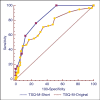Comparison of the Diagnostic Accuracy and Validity of a Short Version of Teen Screen Questionnaire-Mental Health (TSQ -M-Short) for Use in Community
- PMID: 25969607
- PMCID: PMC4418254
- DOI: 10.4103/0253-7176.155621
Comparison of the Diagnostic Accuracy and Validity of a Short Version of Teen Screen Questionnaire-Mental Health (TSQ -M-Short) for Use in Community
Abstract
Background: A few self-administered questionnaires are available for assessing mental health among adolescents in primary-care settings. Brief measures are desirable for use in big-data, epidemiological studies.
Objectives: To evaluate a 7-item version, of the Teen Screen Questionnaire-Mental Health (TSQ-M), the TSQ-M-Short.
Materials and methods: In this prospective cross-sectional study of 140 adolescents, recruited from 6 rural or urban schools, the newly developed TSQ-M-Short as the measure for validation and General Health Questionnaire-12 item (GHQ-12) as the gold standard measure were administered by independent trained raters. Tests for diagnostic accuracy and validity were conducted.
Results: A total TSQ-M-Short score of ≥ 6 had a sensitivity of 76%, specificity of 74%, positive likelihood ratio of 2.99, negative likelihood ratio of 0.33, positive predictive value of 6% and a negative predictive value of 82.1%. The area under curve (AUC) in the Receiver Operating Characteristic (ROC) for the TSQ-M-Short version was 0.84 (95% cumulative incidence (CI) = 0.76-0.89). The AUC for the TSQ-M-Short version was higher than the AUC for the original version, and the difference between the areas was 0.10 (95% CI = 0.02-0.19), which was statistically significant (z = 2.49; P = 0.01). The internal consistency of TSQ-M-Short, as measured by chronbach's α, was 0.34 (95% CI = 0.15-0.48). The construct validity demonstrated a 3-factor structure, which explained 55% of the variance.
Conclusion: The TSQ-M-Short has an overall diagnostic accuracy which is better than the original TSQ-M. Although the original version includes symptoms for more mental health disorders, providing a wider screen. This short version will prove useful in big-data studies.
Keywords: Adolescents; diagnostic accuracy; mental-health; primary-care; questionnaire; validation.
Conflict of interest statement
Figures

References
-
- Kessler RC, Berglund P, Demler O, Jin R, Merikangas KR, Walters EE. Lifetime prevalence and age-of-onset distributions of DSM-IV disorders in the National Comorbidity Survey Replication. Arch Gen Psychiatry. 2005;62:593–602. - PubMed
-
- Kramer T, Garralda ME. Child and adolescent mental health problems in primary care. Adv Psychiatry Treat. 2000;6:287–94.
-
- Coyle JT, Pine DS, Charney DS, Lewis L, Nemeroff CB, Carlson GA, et al. Depression and Bipolar Support Alliance Consensus Development Panel. Depression and bipolar support alliance consensus statement on the unmet needs in diagnosis and treatment of mood disorders in children and adolescents. J Am Acad Child Adolesc Psychiatry. 2003;42:1494–503. - PubMed
-
- Lawrence RS, Appleton Gootman J, SimL J, editors. Adolescent Health Services: Missing Opportunities. Washington, DC: The National Academies Press; 2009. Committee on adolescent health care services and models of care for treatment, prevention, and healthy development, national research council and institute of medicine, board on children, youth, and families. - PubMed
-
- Bowling A. Mode of questionnaire administration can have serious effects on data quality. J Public Health (Oxf) 2005;27:281–91. - PubMed
LinkOut - more resources
Full Text Sources
Other Literature Sources
